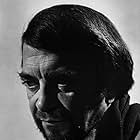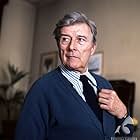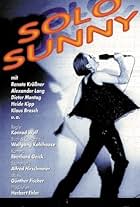As a painter in the court of King Carlos IV, Goya - played by the great Lithuanian actor Donatas Banionis (The Red Tent, Solaris) - has attained wealth and reputation. He believes in King an... Read allAs a painter in the court of King Carlos IV, Goya - played by the great Lithuanian actor Donatas Banionis (The Red Tent, Solaris) - has attained wealth and reputation. He believes in King and Church, yet he is also a Spaniard who dearly loves his people. This contradiction presen... Read allAs a painter in the court of King Carlos IV, Goya - played by the great Lithuanian actor Donatas Banionis (The Red Tent, Solaris) - has attained wealth and reputation. He believes in King and Church, yet he is also a Spaniard who dearly loves his people. This contradiction presents him with a dilemma. Based on Lion Feuchtwanger's novel, Goya is one of ten East German ... Read all
- Awards
- 2 wins & 1 nomination
- Goya's Mother
- (as Veriko Andjaparidze)
- Josefa Goya
- (as Ariadna Shengelaya)
- Director
- Writers
- All cast & crew
- Production, box office & more at IMDbPro
Storyline
Did you know
There are three Goya movies widely available, and this is the one that comes closest to the man's real life, his real world. More on the others in a minute. This 1971 epic is actually an innovative, emotional Eastern European (and Soviet) production not in German, and it comes out of an era that in the US would be called New Hollywood, where the rules are made to be broken. But this is ultimately a test of Communist social and artistic ideals, and any messages in it have to be read in that context. It is certainly earnest and deeply intense. It is also, weird to say, Germanic, filled with big bawdy characters that strike you as not quite "Spanish," and of course Goya is all about the Spanish and Spain. The action is mostly set in Madrid (and filmed in the Eastern Bloc). The full title is revealing: Goya, or the Hard Way to Enlightenment.
The lead is a man who wants truth, but he doesn't quite know it at first. Goya the painter is successful and is mostly beholden to his job as a court painter. There are portraits galore. The actor is a Lithuanian powerhouse, Donatas Banionis, and he is both commanding and believable. Around him is a huge cast of friends and patrons and one particular model, the Duchess of Alba, played by Yugoslavian actress Olivera Katarina (with a passing similarity to the truly Spanish Penelope Cruz). Goya and the Duchess have what is historically a speculative love affair, and it is useful in the movie as a device to keep the wide-ranging events of Goya's life contained. Most famously, the Duchess is depcited in a pair of paintings, one nude and one clothed, as a flaunting of Goya's power against authority.
The reigning threat to the painter's well-being--and to everyone's--is the Spanish Inquisition, that enforcement of moral code by the church with extreme punishment for even small infractions, including saying things that were heretical. It surely kept most people quiet and obedient, or on the run to France which in Goya's day saw the 1789 Revolution and a rise of liberal ideas like tolerance and freedom. Goya was asked to appear more than once before the authorities, and managed to survive even though some of his work was unconventional. He at first showed ordinary people looking ordinary, a realism seen as distasteful, and later showed people as demons, as if we are all possessed in some measure.
All of this is well done, very well done, with tight and dramatic filming (including selective focus), some innovative editing and surreal sequences, and edgy modern music. But what is most amazing is the sense of rebellion contained in Goya and his artist contemporaries against the authorities, because this is Communist East Germany we are talking about, and a movie that encourages freedom of thought would seem to be verboten. It's interesting, for sure, to see the authorities are not cruel, but simply moralizing and closed-minded (and history shows that they truly were cruel, both in Spain and in the DDR). It's also revealing that it leaves out Goya's final years, where he fled Spain for France.
See this film, by all means. It was originally a 70mm expensive production and it's all extremely high quality. And passionate. The only version available is the director Kondrad Wolf's own shorter edit, at just over two hours.
The other two Goya films? Far more artistic and magical is the filming and intent of the Spanish 1999 film "Goya in Bordeaux," which has a more limited scope and its own flaws but is so utterly gorgeous at times you can feel the power of the art. The more recent "Goya's Ghosts" has star power, and it takes liberties by inventing an entirely new story with Goya as a kind of spectator, but it is actually more superficially sensational, though visually rich.
"Goya" in East German hands is a serious work, a little long, but so overflowing with the visuals and music it's hard not to get sucked in. It also has the folk singing of Carmen Herold, who plays Maria Rosario singing two powerful earthy songs in the film. This, even more than Goya's love for the Duchess, changes both his thinking and the direction of the story, because Rosario refuses to say she was guilty of something she was not, and she is condemned to death. It's quite beautiful in every way, and is a testament to sincerity and truth above all, which is was Goya, the man and the painter, achieved.
- secondtake
- Aug 8, 2011
- Permalink
Details
- Release date
- Countries of origin
- Languages
- Also known as
- Goya
- Filming locations
- Production companies
- See more company credits at IMDbPro
- Runtime2 hours 16 minutes
- Color
- Sound mix
- Aspect ratio
- 2.20 : 1
Contribute to this page































